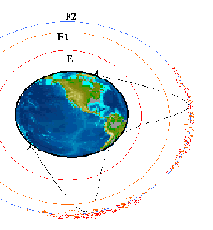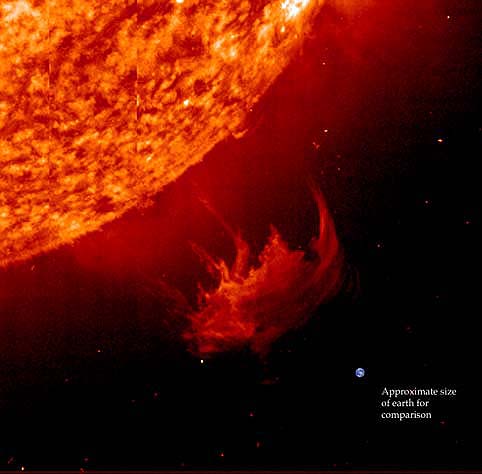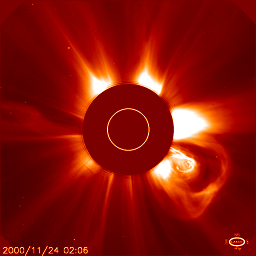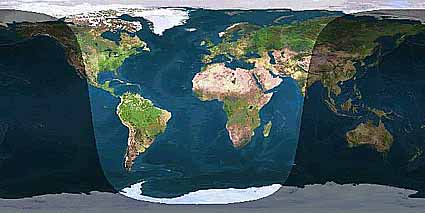| 11 Meter Radio Propagation |
| Propagation : is the study of how radio waves travel through the earth's atmosphere, from one point to another. For successful radio communications, it is desirable to have a good understanding of the characteristics of radio waves and how they are influenced by solar and geomagnetic fields as they travel through the earth's atmosphere. There is a vast amount of information on radio propagation covered in great detail on the net, so I have included a list of sites which you can find more detailed information (see Link Pages). Here, I hope to cover the basics, such as the various types of radio wave propagation and how it effects the 11-Meter band. IONOSPHERE Radio communications is effected by the variable conditions that exist in the earth's atmosphere, and this can be divided into three main regions. The Troposphere, which extends to a height of about 10 km., The Stratosphere, which extends from 10 to 60 km., and The Ionosphere, which extends from 60 to 1000 km above the surface of the earth. It is the Ionosphere which we look to for long distance propagation. The radiation from the sun results in the removal of electrons from atoms present in the upper regions of the atmosphere, forming the ionosphere. These electrically charged particles in the ionosphere, bend or reflect the transmitted signal back towards the ground where it can then be bounced back into the ionosphere again, what we refer to as "Skip" conditions. Ultra violet light from the sun is the primary cause of this ionization, (splitting of molecules into positive and negative ions) which is found at various heights in the atmosphere and varies in intensity from region to region, time of day, season and year in the 11 year sunspot cycle. Long distance or " DX" radio communications depend on this ionization. The amount by which a radio wave is reflected and bounced, depends on the intensity of the ionization and also the wavelength or frequency used. |
| Multi hop propagation over long distance is usually more complex, than in the diagram on the left, because of different ionospheric conditions. The distance of the "hop" depends upon the angle at which it enters the ionized layer and the layer height. Maximum distance covered by one hop is approx. 1250 miles when the reflection is from the E layer, and 2500 miles from the F2 layer. So you can see how important it is to have a a low wave-angle on the antenna when working DX. The lower the wave angle, the less number of reflections and the less ground loss. |
| SUNSPOTS AND IONOSPHERIC STORMS Sunspot eruptions on the surface of the sun can cause great disturbances in the ionosphere known as ionospheric storms, and these are usually followed by other disturbances in the earth's magnetic field. These storms have a great effect on radio communications. On the lower frequencies, they decrease the daytime absorption of signals and thus increase the signal strength. During night time, the signal strength is below normal. On the higher frequencies, such as 11 Meters, communications become impossible depending on the intensity of the storm. These storms, which can cause "radio blackouts", are most common during the eleven year sunspot cycle peak. Solar Terrestrial Activity Report Easy to read chart, with twice daily updates. GROUND WAVES: This refers to surface or line-of-sight Propagation between two locations. The distance depends on a number of factors, such as height of the transmitting and receiving antennas, type of antennas and local terrain. Usually no greater than a hundred miles or so on HF. MAXIMUM USABLE FREQUENCY: This is a term we often see on Propagation Charts, usually referred to as MUF. It is always best to use the highest possible frequency because there is less absorption the higher the frequency. M.U.F. gives us the greatest strength at the receiving end for a given transmitting power output. Although, on Eleven Meters, we do not have the choice to change frequency, depending on the time of day, seasonal variations, etc. which effects propagation, it will however, give us a good indication of what to expect on the band. SOLAR RADIATION: The solar radiation which effects propagation is of two kinds; ultraviolet light (UV) and charged particles (x-rays). The first kind travels at the speed of light, (186.000 miles per second) as does all electromagnetic radiation, so that the effects are felt about 8 minutes after the event. The second kind, the x-ray particle radiation can take up to 40 hours to reach the earth. SUNSPOT CYCLES: Apart from rotating once every 28 days, the sun goes through an "Eleven Year Cycle", or to be more exact, a 9 to 14 year cycle. Over this period, the number of sunspots increase and decrease. At the period of sunspot maximum, when the sun's activity is most active, propagation is at it's best and it is possible to work great distance. But during the sunspot minimum, the bands and especially 11 Meters, can be "dead" for long periods. GREAT CIRCLE PATHS: Between any two locations on the earth, there is always two great circle paths connecting them. One is the shortest distance between the two points, and the other is the longest way in the opposite direction. From the east coast of Australia to Europe, the short-path is N/W across the land mass of South East Asia. While the long-path, on the other hand, is across the Pacific, Central America and the Atlantic..... mostly over water. Whenever long-path propagation exists, it usually results in much stronger signals. During the daylight hours when the short-path to Europe is inoperative, it is not uncommon to work via the long-path. GREY LINE PROPAGATION: The grey line is a band around the Earth that separates the daylight from darkness. Propagation along the grey line is very efficient. One major reason for this is that the D layer, which absorbs HF signals, disappears rapidly on the sunset side of the grey line, and it has not yet built upon the sunrise side. More information on DX-ing the Twilight Zone can be found on my other site... DX-Pacific. Also, check out the real-time Greyline Propagation Map below. |
| The "grey line" is a band around the Earth that separates the daylight from darkness. During these times, Propagation along the grey line is very efficient. One major reason for this is that the D layer, which absorbs HF signals, disappears rapidly on the sunset side of the grey line, and it has not yet built upon the sunrise side. During sunrise and sunset, you will notice propagation opens up for a short period to other areas along this grey line or twilight zone . Using the Grey line map below, you can work into areas along this zone. It is important that you know the exact beam headings and time of twilight for the targeted area. Geoclock or other similar software is useful for locating the grey line or zone. Some very surprising contacts can be made by "surfing" this little known means of radio propagation. Click on the above map image to see the current position of the grey line terminator. (Grey Line Map image and link due to the kind courtesy of Doug Brandon N6RT of QSL Net) |
 |
| Greyline Propagation Map |
|
| Solar Activity Monitor This X-ray Solar status and Geomagnetic monitor downloads data periodically from the NOAA Space Environment Center FTP server, and is updated every ten minutes with the current status. |

|
| X-Ray Solar Status The previous 24 hours of 5 minute Long-wavelength X-ray data from each satellite (GOES 8 and GOES 10) is analyzed, and an appropriate level of activity for the past 24 hours is assigned as follows: Normal: Solar X-ray flux is quiet. Active: Solar X-ray flux is active. M Class Flare: An M Class flare has occurred. X Class Flare: An X Class flare has occurred. Mega Flare: An unprecedented X-ray event has occurred. Geomagnetic Field Status The Geomagnetic Field status monitor downloads data periodically from the NOAA Space Environment Center FTP server. The previous 24 hours of 3 hour Planetary Kp Index data is analyzed and an appropriate level of activity for the past 24 hours is assigned as follows: Quiet: the Geomagnetic Field is quiet. Active: the Geomagnetic Field has been unsettled. Storm: A Geomagnetic Storm has occurred. For more information, visit Majestic Research For information about solar storms, visit NOAA Space Environment Center |
 |
 |
| Mega Flare with Earth as comparison - NASA PHOTO |
| TRANSMITTER |
| RECEIVER |
| Visit the Solar Data Analysis Center SDAC at NASA for more spectacular images taken during the recent Solar Maximum and current Solar Images. Photos "Courtesy of SOHO consortium. SOHO is a project of international cooperation between ESA and NASA." http://sohowww.nascom.nasa.gov/ |
 |
| HOME DX-PACIFIC |
